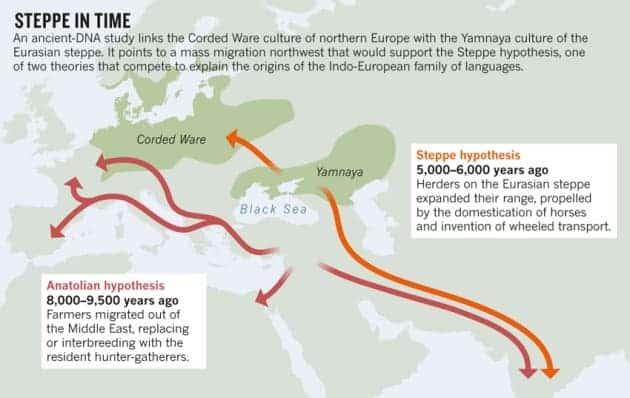Languages like English, Greek or Hindu, all Indo-European tongues, stem from a common ancestral language family which originated 5,500 – 6,500 years ago, on the Pontic-Caspian steppe stretching from Moldova and Ukraine to Russia and western Kazakhstan. The findings were reported by a group of linguists at University of California, Berkeley after data from more than 150 languages were analyzed. Today, some 3 billion people speak the more than 400 languages and dialects that belong to the Indo-European family.
The mother tongue

Credit: W. Haak et al.
The team led by Will Chang looked at more than 200 sets of words from living and historical Indo-European languages to trace their root to a common pro-language. The word’s rate of change helped them to developed a statistical model that showed languages which first used these words began to diverge approximately 6,500 years ago, in accordance with the steppe hypothesis. The hypothesis suggests that languages in the Eurasian steppe first emerged 5,000–6,000 years ago, when the domestication of horses and invention of wheeled transport would have allowed herders there to rapidly expand their range. Findings were reported in the journal Language.
Another study, posted to the bioRxiv.org preprint server on 10 February, looked at ancient DNA samples from the bodies of 94 individuals who lived across Europe between 8,000 and 3,000 years ago. The data confirmed the arrival of Middle Eastern farmers in Europe between 8,000 and 7,000 years ago. David Reich, an evolutionary and population geneticist at Harvard Medical School in Boston, Massachusetts, also found however that there was evidence of a second migration which happened earlier. The DNA recovered from steppe herders called the Yamnaya, who lived in what are now Russia and Ukraine around 5,000 years ago, closely matched that of 4,500-year-old individuals from present-day Germany, who were part of a group known as the Corded Ware culture that encompassed most of northern Europe.
“This seems like very striking support for at least part of the traditional steppe model of Indo-European diversification,” says Andrew Garrett, a historical linguist at the University of California.
However, this matter is far from settled. The favorite theory among linguists for the Indo-European tree origin posits that the first speakers were farmers living in Anatolia (present day Turkey). Many supporters of the Anatolian hypothesis remain staunchly unconvinced. Paul Heggarty, a linguist at the Max Planck Institute for Evolutionary Anthropology in Leipzig, Germany, questions Garrett’s methods, arguing that, for example, linguists cannot be sure if the Latin attested to in written documents really was the direct ancestor of later Romance languages, rather than some dialect of Latin for which no record remains.
Genes and words have several similarities, and language evolution has conventionally been mapped using a “family tree” format, but that’s not to say speculations regarding population migration are necessarily valid when speaking about language migration as well. Unfortunately, ancient written texts can teach us so much. If only written slabs had survived from 6,000 years ago. What marvels would we learn of today?









